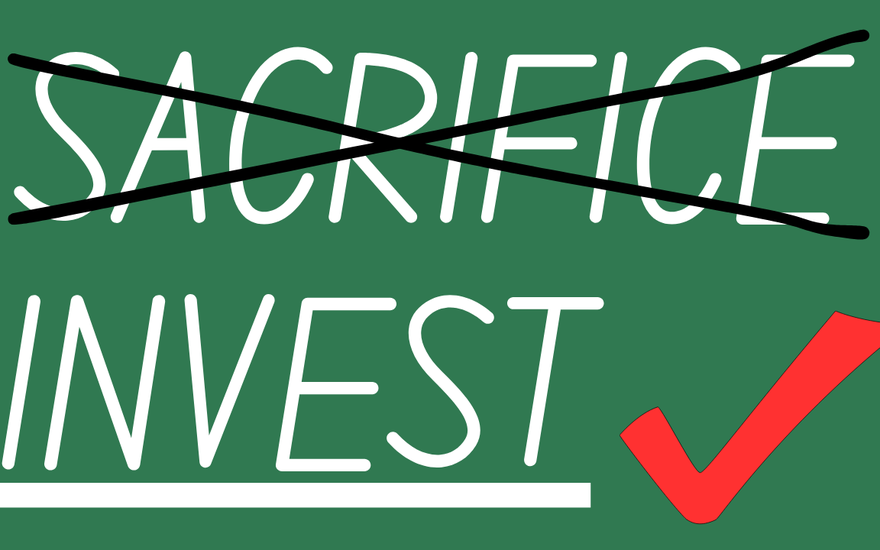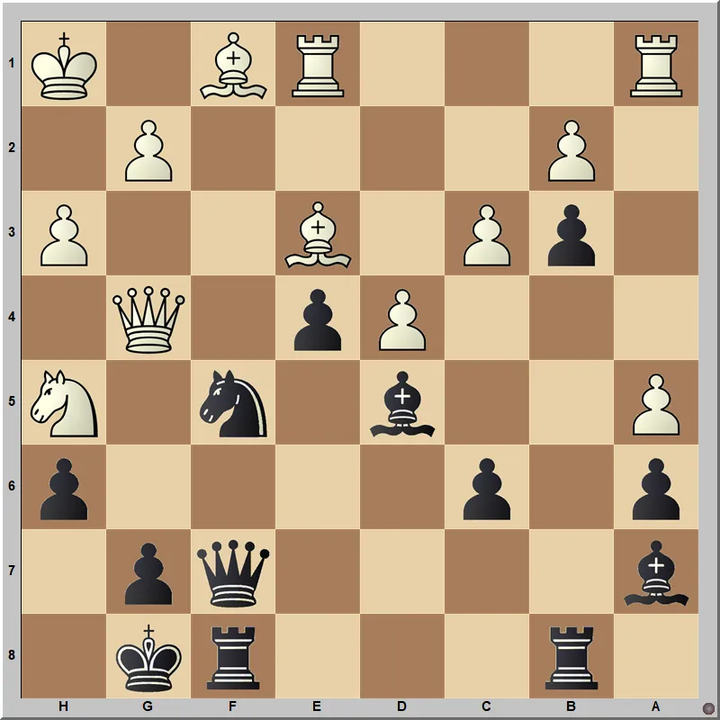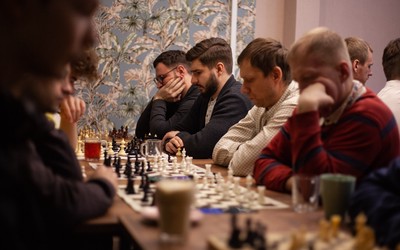
"Sacrifice" vs "Invest" in Chess
How a change of words can help our mindset during a game
What do you think of when you hear the word “sacrifice”? You may think of phrases like “sacrificing one’s time” or “sacrificing for the greater good”. If you’re a baseball fan you may think of a “sacrifice fly” or “sacrifice bunt”. If you’re reading this blog though then you’re most likely a chess player and the first thing that came to your mind was a “pawn sacrifice”, a “piece sacrifice” or “sacrificing material”.
What about when you think of the word “invest”? You may think about investing time or money. You may think about “investing in yourself”, “investing in a relationship” or investing in the stock market. This isn’t really a word that is used much (or at all) in chess terminology.
If we think about these two words “sacrifice” and “invest”, it ends up that they have a somewhat similar definition. According to the Merriam-Webster dictionary, one of the definitions for “sacrifice” is the “surrender of something for the sake of something else” while “invest” is defined as “to make use of for future benefits or advantages”. You can sacrifice something for a future gain just like you can invest something for a future gain. Despite this overlap, I would make the claim that people generally don’t like to “sacrifice” things but would rather “invest” in things. The connotation of each word is very different.
Ok, this was a much longer introduction than I had expected but here’s where this ties into chess. The main thing that is “sacrificed” in chess is material. A pawn or a piece. But when we are thinking about sacrificing material, it is usually with the goal of an immediate gain in return. We will gladly sacrifice a bishop if we get to win a rook a few moves later. We are happy to sacrifice our queen if it means we get checkmate soon (and then we can post the tactic on Reddit afterwards).

In the position above no one would have any problem with “sacrificing” their queen by playing 1...Qxh5 as long as they see the follow up 2. Qxh5 Ng3+ then 3...Nxh5 where Black ends up being ahead a piece. But what about sacrifices where we don’t get a larger material advantage or checkmate afterwards?
A “positional sacrifice” is defined as “a material sacrifice that results in a positional advantage”. What is a “positional advantage”? Here’s a few examples:
- Having the bishop pair when your opponent doesn’t
- Having more space compared to your opponent
- Having a better pawn structure than your opponent
- Having a good minor piece while your opponent is left with a bad minor piece
- Etc.
These are different examples of advantages just like having more material than your opponent is a type of advantage too. However, many players tend to focus too much on the material count during a game and don’t give enough thought to other factors/advantages in the position. Especially at the beginner level, a player would rather be ahead a pawn but be cramped with less space and have pawn weaknesses than to be down a pawn but have a big space advantage and no weaknesses. Of course, it is always going to depend on the specific position on the board but ultimately many players don’t even consider the idea of a “positional sacrifice”. Why is this?
One reason is that many players don’t know how to use positional advantages and convert them into wins. If I asked you “What is the game plan when you’re ahead material?”, pretty much everyone has some kind of basic understanding of what they should do: Trade pieces in order to get closer to the endgame where you can use your material advantage to win the game easier. However, if I asked you “What is the game plan when you have a space advantage?” it is probably a bit tougher to answer. (My answer is to first secure and defend your center and pawns that give you the space advantage. Next, either press forward with your pawns to gain more space and strangle the opponent or use your better piece mobility to transfer your pieces towards an attack against the opponent’s king). Because of this, if a player is ahead material then they have an idea of what they should be doing while if they have a positional advantage then it’s much less obvious what they should be working towards.
Another reason that many players don’t feel comfortable making a positional sacrifice is because there is no immediate regain of material. Most sacrifices in chess result in a recoup of our material, a big attack or a checkmate. Things like the “Greek Gift sacrifice” or the “double-bishop sacrifice” which both tend to result in a mating attack. However, positional sacrifices are different in that you are going to stay down material for a while and have no guarantee that you will equalize or pull ahead in material. And this makes people uncomfortable. Simply put, many people don’t like to play down material and don’t know how to play correctly in these type of situations. Early on when we learn chess we are taught the point-count of the pieces and are giddy when we have more pieces or pawns than our opponent. We probably have thought something like “I’m up a pawn/piece/exchange so I’m better” without even considering other factors in the position (raise your hand if you’ve thought this way before). However, as we progress we come to learn that being ahead material does not mean that the win is guaranteed. Many other factors play into one side winning the game.
In order to consider the option of a “positional sacrifice”, I like to think of this concept using a different name. Instead of thinking of it as a “sacrifice”, I think of it as a “positional investment”. We are investing material in order to give ourselves positional gains. I think that this has a better connotation and makes it a bit easier to consider the possibility during a game. This change in terminology could extend to other types of sacrifices too (Greek Gift sacrifice or Greek Gift investment?) but I’m not going to delve into that side of things here. The big thing about a positional investment is that we are willing to give up some material for a positional gain. Let’s look at a few positions that show this concept:

Here White is ahead a pawn but is under pressure. Our bishop (which is blocked in and bad) and pawn on f4 are both attacked by black’s queen and our king is a little bit exposed. What moves would you consider here? Would you think about playing something like Bc1 to defend against both of black’s threats? That feels like a bit of a sad move doesn’t it? Well, it ends up that the best thing to do is to play 1. e6! creating the strong threat of exf7+ forking black’s king and rook. Black cannot capture the pawn with their rook since that would leave the rook on a8 undefended. Instead, Black should respond with 1...fxe6. Unfortunately we cannot play Qxg7# since the f5-knight is defending but we can now play 2. Be5 to defend the f4-pawn.

What has changed in the position? We are no longer ahead material but we now have a monster bishop that has fantastic open diagonals all across the board towards both the kingside and queenside. We didn’t sacrifice a pawn. No, we invested a pawn in order to improve our bishop’s location and turn what was once a passive piece on b2 stuck behind the e5-pawn into a monster on the e5-square. White has good play in the resulting position with ideas like Rd7 in the future. Black also has a bunch of isolated pawns on a6, c5 and e6 which will be difficult to defend in the long-term.

Here we have an equal material position but our knight on c4 is under attack. What moves would you consider here? Playing ...Nd6 or ...Nb6 seems fine but what about playing 1...Nxe3! 2. Bxe3 Rxe3! 3. Rxe3 Bxf4.

We are down the exchange but ahead one pawn which means we are technically one point behind in material. On the other hand, we have the bishop pair (especially a strong dark-square bishop that White doesn’t have), a space advantage (three pawns on the fifth rank vs one pawn on the fourth rank) and White also has a weak isolated pawn on d4. After white’s rook retreats then we can play things like ...Bd7 to defend our c6-pawn along with ...Ne6 and ...Qf4 to attack the d4-pawn. We end up with a strong position despite being down a little bit of material. We didn’t sacrifice the exchange. No, we made an investment in our position.
Positional sacrifices investments are one of the harder concepts in chess to apply but hopefully they have become a bit easier to understand and come to terms with (pun intended) after reading this blog post. Don’t think of it as a sacrifice. Think of it as an investment!
If you'd like to receive posts like this in your email inbox, then you can subscribe to my free blog here: https://chesschatter.substack.com/
